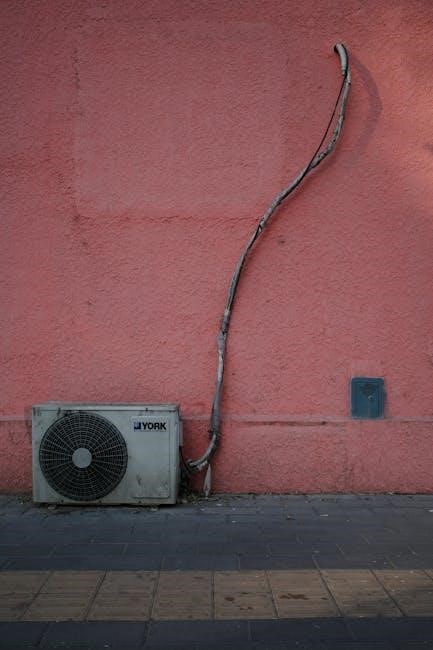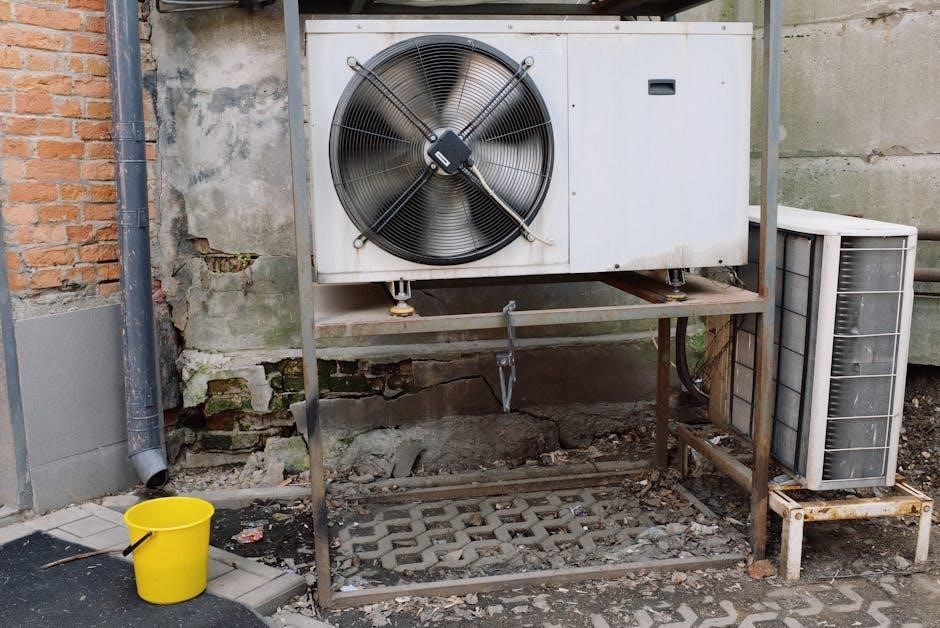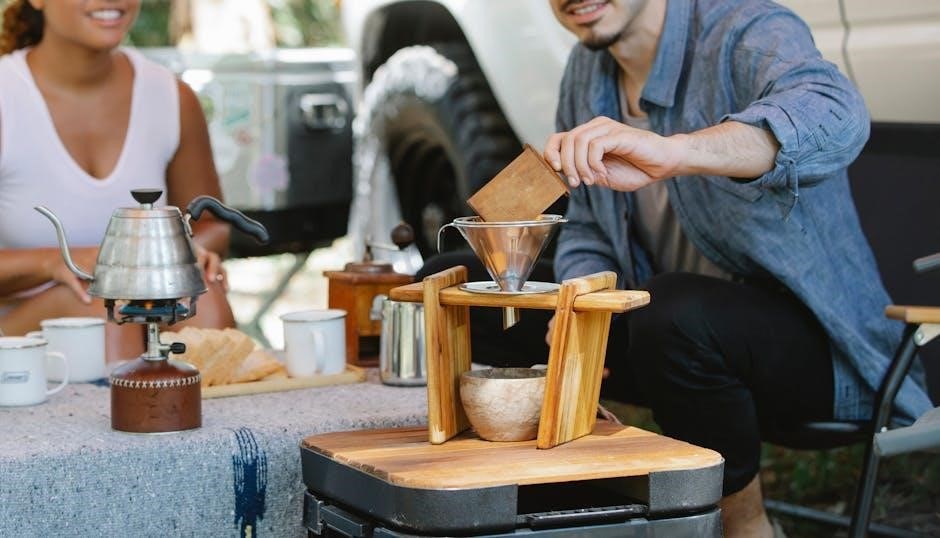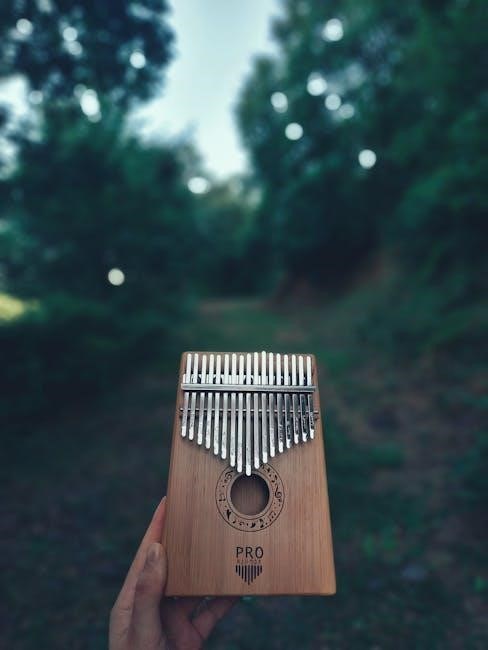Welcome to the Soleus Air Portable Air Conditioner manual․ This guide provides essential information for proper installation, operation, and maintenance to ensure optimal performance and safety․ Read thoroughly to understand features, troubleshooting, and care tips for your unit․
Overview of the Soleus Air Portable Air Conditioner
The Soleus Air Portable Air Conditioner is a versatile and efficient solution for cooling and heating spaces․ Designed for ease of use, it offers advanced features such as digital controls, remote operation, and multiple modes (cooling, heating, and fan)․ With models like the LX-140, it provides up to 14,000 BTU of cooling and heating power, making it suitable for various room sizes․ Its portability and minimal installation requirements make it ideal for homeowners and office spaces․ The unit also includes a heat pump function for energy-efficient heating and dual hose systems for improved airflow․ Built with user-friendly designs, it ensures comfort and convenience, while its compact size fits seamlessly into any environment․ This product is a reliable choice for year-round climate control․
Importance of Reading the Manual
Reading the manual is crucial for safe and effective use of your Soleus Air Portable Air Conditioner․ It provides detailed instructions for installation, operation, and maintenance, ensuring optimal performance․ The manual explains how to handle features like digital controls, remote functionality, and mode switching․ It also outlines safety precautions, such as testing the LCDI plug and addressing current leakage․ Understanding the manual helps prevent issues like water leaks and noise problems․ Additionally, it guides troubleshooting common errors, such as the E5 code, and resetting the unit․ By following the manual, you can extend the unit’s lifespan and maintain efficiency․ Always refer to it for proper care and usage tips, ensuring your Soleus Air conditioner operates safely and effectively throughout the year․

Product Specifications
The Soleus Air Portable Air Conditioner models, such as LX-140, offer 14,000 BTU cooling and heating capacities․ Key features include dual hose systems, digital displays, and remote controls for efficient operation․
Model Numbers and Variants
Soleus Air offers various portable air conditioner models, including the LX-140, TM-PAC-08E3, TM-PAC-10E3, and TM-PAC-12E4․ Each model varies in BTU capacity, with the LX-140 providing 14,000 BTU for cooling and heating․ The SG-PAC-08E3 is another popular variant, designed for efficient performance․ These models cater to different space requirements, ensuring optimal cooling and heating solutions for various room sizes․ When selecting a model, consider the square footage of the area to ensure proper climate control․ Always refer to the specific model number in the manual for accurate specifications and features tailored to your unit․
Cooling and Heating Capacities
The Soleus Air Portable Air Conditioner offers versatile cooling and heating capacities, with models like the LX-140 providing 14,000 BTU for cooling and 14,200 BTU for heating․ This dual functionality makes it ideal for year-round use, efficiently managing temperatures in spaces up to 700 square feet․ The unit’s heat pump design ensures energy efficiency, while the cooling mode effectively lowers room temperature․ For accurate performance, always match the BTU capacity to the room size․ The dual-hose system enhances cooling efficiency by expelling hot air outside, while the heat pump reverses the process for heating․ Refer to your specific model’s manual for precise capacity details tailored to your needs․
Key Features and Design
The Soleus Air Portable Air Conditioner is designed for convenience and efficiency, featuring a compact, space-saving design․ It includes a dual-hose system for improved cooling performance and a built-in LCDI plug for enhanced electrical safety․ The unit offers a 90-degree oscillating head and adjustable air direction for even air distribution․ The remote control and digital display ensure easy operation, while the heat pump function provides both cooling and heating capabilities․ Additional features include a condensate pump compatibility and a self-evaporative system to minimize water drainage issues․ The sleek and modern design combines the functionality of a portable AC, heater, and fan, making it a versatile solution for year-round comfort․ Its portability and easy installation make it ideal for various room sizes and layouts․
Installation and Setup
Unpack and prepare the unit, ensuring all components are included․ Install the window kit and connect the exhaust hose properly․ Follow manual instructions for venting setup․
Unpacking and Preparing the Unit
Begin by carefully unpacking the Soleus Air Portable Air Conditioner from its box․ Ensure all components, including the unit, remote control, window kit, and exhaust hose, are included and undamaged․ Inspect the unit for any signs of shipping damage․ Before operation, place the air conditioner on a flat, stable surface in a well-ventilated area․ Remove any packaging materials and protective coverings․ Familiarize yourself with the control panel and ports․ Refer to the user manual for detailed diagrams and descriptions of each part․ Ensure the area around the unit is clear to allow proper air circulation․ Finally, plug in the unit and test the power button to confirm it is functioning correctly․
Understanding the Venting System
The venting system is crucial for your Soleus Air Portable Air Conditioner to function efficiently․ It ensures hot air and moisture are expelled outside, preventing overheating and improving cooling performance․ The system includes an exhaust hose and a window kit․ Proper installation is essential; the exhaust hose must be securely connected to both the unit and the window kit․ For dual-hose models, a second hose is used for intake, enhancing efficiency․ Always use the provided venting components and avoid extensions unless specified․ Regularly inspect the hose for kinks or blockages, as these can reduce airflow․ Ensure the venting system is properly sealed to prevent air leaks, which can lower performance․ Refer to the manual for specific venting requirements for your model․
Installing the Window Kit
Installing the window kit is a critical step for proper venting of your Soleus Air Portable Air Conditioner․ Begin by opening the window and measuring the width to ensure the window kit fits securely․ Insert the adjustable side panels into the window frame, ensuring a snug fit․ For sliding windows, place the solid panel between the adjustable sides to complete the seal․ Tighten the panels until they hold firmly in place․ Once installed, attach the exhaust hose to the window kit, ensuring a secure connection․ Double-check that all gaps are sealed with foam strips or weatherstripping to prevent air leaks․ Proper installation ensures efficient operation and prevents hot air from recirculating into the room․ Always follow the manufacturer’s instructions for specific model requirements․
Connecting the Exhaust Hose
Connecting the exhaust hose to your Soleus Air Portable Air Conditioner is essential for proper ventilation․ Begin by aligning the hose connector with the unit’s exhaust port, ensuring a secure, twist-and-lock connection․ Once attached, guide the hose through the window kit, making sure it fits snugly without kinking or bending․ Check for any gaps or leaks by running your hand along the connection points․ If necessary, use the provided foam seals to tighten the fit․ Proper connection ensures hot air is vented outside efficiently, preventing recirculation and maintaining optimal cooling performance․ Always refer to your specific model’s manual for detailed instructions, as connector designs may vary slightly between models․

Operating Instructions
Operate your Soleus Air Portable Air Conditioner by using basic controls, remote control, or digital display․ Set modes, temperatures, and fan speeds for optimal comfort and efficiency․
Basic Controls and Functions
The Soleus Air Portable Air Conditioner features an intuitive control panel with buttons for mode selection, temperature adjustment, and fan speed control․ The MODE button allows switching between cooling, heating, and fan modes, while the TEMP buttons adjust the desired temperature․ The FAN button toggles fan speeds (low, medium, high) for customized airflow․ Additionally, the TIMER button enables scheduling operation for up to 24 hours․ The POWER button turns the unit on/off․ LED indicators display the current mode, temperature, and timer settings․ Use these controls to optimize comfort and efficiency, ensuring proper operation according to your needs․
Using the Remote Control
The remote control provides convenient operation of your Soleus Air Portable Air Conditioner․ It allows you to adjust temperature, fan speed, and mode (cool, heat, fan) from across the room․ Press the MODE button to cycle through modes, and use the TEMP buttons to increase or decrease the set temperature․ The FAN button adjusts airflow speed, while the TIMER button enables scheduling․ Aim the remote at the unit’s infrared sensor for reliable control․ Replace batteries if the remote fails to respond․ Always ensure the remote is within range and unobstructed for optimal functionality․ Regularly check battery life to maintain seamless operation․ Use the remote to customize your comfort settings efficiently and effortlessly․
Setting the Digital Display
Setting the digital display on your Soleus Air Portable Air Conditioner is straightforward; Use the control panel or remote to navigate through options․ Press the MODE button to select cooling, heating, or fan mode․ Adjust the temperature using the TEMP buttons, and the display will show the set temperature․ The FAN button allows you to choose fan speed․ For timer settings, press the TIMER button and use the TEMP buttons to set the desired duration․ The display will confirm your settings and show active modes․ Ensure the display is clear and functional for accurate control․ Familiarize yourself with the display to optimize your unit’s performance and enjoy precise climate control in your space․
Switching Between Cooling, Heating, and Fan Modes
To switch modes on your Soleus Air Portable Air Conditioner, press the MODE button on the remote or control panel․ The digital display will show the active mode: Cool, Heat, or Fan․ For cooling, the unit will lower the temperature, while heating will warm the space․ Fan mode circulates air without changing the temperature․ Some models feature a heat pump, which requires venting, while others use resistive heaters that do not need an exhaust hose․ Ensure the appropriate mode is selected based on your needs․ Adjust settings like temperature and fan speed as desired․ The display will confirm the mode and any additional settings․ This feature allows you to customize your comfort efficiently year-round․

Maintenance and Care
Regular maintenance ensures your Soleus Air Portable Air Conditioner runs efficiently․ Clean the air filter, drain condensate water, and wipe the exterior to prevent dust buildup and water leaks․ Proper care extends the unit’s lifespan and performance, ensuring reliable operation during heating and cooling seasons․ Always follow the manual’s guidelines for storage and upkeep․ This will help maintain your unit’s effectiveness and safety over time, preventing common issues like water leaks and error codes․ Regular checks and simple cleaning tasks will keep your air conditioner functioning optimally year-round․
Cleaning the Air Filter
Cleaning the air filter is essential for maintaining your Soleus Air Portable Air Conditioner’s efficiency and performance․ Locate the air filter, typically found behind the front grille or in the rear of the unit; Turn off the air conditioner and unplug it before proceeding․ Gently remove the filter and inspect for dust or debris․ Use a soft brush or vacuum cleaner to remove loose particles․ For stubborn dirt, wash the filter with mild soap and warm water, then allow it to dry completely before reinstalling․ Regular cleaning prevents reduced airflow and energy efficiency․ Replace the filter if it is damaged or worn out․ A clean filter ensures better air quality and helps prevent error codes related to airflow issues․ Always follow the manufacturer’s instructions for your specific model․
Draining Condensate Water
Draining condensate water is crucial for maintaining your Soleus Air Portable Air Conditioner’s performance and preventing leaks․ Locate the water tank, usually at the bottom or rear of the unit․ Turn off the air conditioner and unplug it before draining․ Carefully remove the tank and empty it into a sink or bucket․ If your model has a built-in drainage system, ensure the hose is properly connected to a drain or outside․ Regularly inspect for blockages or water accumulation․ For models without a drainage system, consider using a condensate pump for efficient water removal․ Always refer to your specific model’s manual for detailed instructions to avoid water overflow and ensure smooth operation․
Cleaning the Coils and Exterior
Cleaning the coils and exterior of your Soleus Air Portable Air Conditioner is essential for maintaining efficiency and performance․ Turn off and unplug the unit before cleaning․ Use a soft brush or vacuum cleaner to gently remove dust and debris from the evaporator and condenser coils․ For the exterior, wipe with a damp cloth, avoiding harsh chemicals or abrasive materials․ Regular cleaning prevents dust buildup, which can reduce airflow and efficiency․ Ensure the unit is dry before turning it back on․ This simple maintenance step helps extend the lifespan of your air conditioner and ensures optimal cooling and heating performance throughout the year․
Storing the Unit During Off-Season
Properly storing your Soleus Air Portable Air Conditioner during the off-season ensures optimal performance and longevity․ First, drain all condensate water from the unit to prevent mold and mildew․ Clean the exterior and interior, including the air filter, and ensure the unit is completely dry․ Store the air conditioner in a cool, dry place away from direct sunlight and moisture․ Use a breathable cover to protect it from dust․ Avoid storing the unit in extreme temperatures or humid environments․ Additionally, store the remote control and accessories separately in a safe place․ Proper storage helps maintain efficiency and ensures the unit is ready for use when needed again․

Troubleshooting Common Issues
Common issues include error codes, water leaks, and noise․ Reset the unit, check for blockages, or contact customer support for assistance with persistent problems․
Identifying Error Codes (e․g․, E5 Error)
The E5 error code typically indicates a problem with the control board or sensor issues․ To resolve this, try resetting the unit by pressing the TEST and RESET buttons on the LCDI Plug․ If the error persists, check for blockages in the air sensor or wiring connections․ Avoid ignoring the issue, as it may lead to further damage․ If the problem remains unresolved, contact Soleus Air Customer Service for professional assistance․ Regular maintenance and proper usage can help prevent such errors․ Always refer to the manual for detailed troubleshooting steps․
Resetting the Unit
To reset your Soleus Air Portable Air Conditioner, press and hold the TEST button on the LCDI Plug until the circuit trips, disconnecting power to the unit․ Then, press the RESET button to restore power․ If the issue persists, ensure the unit is unplugged for 5 minutes before retrying․ This process often resolves minor electrical or sensor-related issues․ If resetting doesn’t work, check for current leakage or contact Soleus Air Customer Service for assistance․ Regular resets can help maintain optimal performance and address unexpected shutdowns․ Always follow safety guidelines when performing resets to avoid potential hazards․ For detailed steps, refer to your user manual or contact technical support for further guidance․
Fixing Water Leaks and Overflow
To address water leaks or overflow in your Soleus Air Portable Air Conditioner, first inspect the water tank and drain hose for blockages or damage․ Ensure the drain hose is securely connected and positioned correctly․ If the unit stops due to a full water tank, empty it promptly․ For persistent leaks, check for any internal damage or loose connections; Regularly cleaning the drain system can prevent such issues․ Consider installing a condensate pump to automate water drainage, especially in high-humidity environments․ Always turn off the unit before performing any maintenance․ If leaks persist, consult the user manual or contact Soleus Air Customer Service for professional assistance․ Proper drainage is essential for optimal performance and longevity of your air conditioner․
Addressing Noise or Vibration
To minimize noise or vibration from your Soleus Air Portable Air Conditioner, ensure the unit is placed on a level, stable surface․ Check for loose screws or components and tighten them if necessary․ Excessive vibration may indicate improper installation or uneven flooring․ Use rubber pads or anti-vibration mats to reduce noise․ If the unit is operating noisily, inspect the fan or compressor for obstructions․ Regular maintenance, such as cleaning the air filter, can also help reduce operational noise․ If issues persist, refer to the troubleshooting section or contact Soleus Air Customer Service for assistance․ A well-maintained unit ensures quieter operation and optimal performance;

Safety Guidelines
Ensure the LCDI Plug is tested regularly by pressing the TEST button; it should trip, cutting power․ If it fails, do not reset—contact Soleus Air support immediately․ Proper ventilation prevents water leaks and ensures efficient operation․ Always follow electrical safety precautions to avoid hazards․
Electrical Safety Precautions
To ensure safe operation, always test the LCDI Plug by pressing the TEST button; it should trip, cutting power to the unit․ If the plug fails to trip, do not reset it—immediately contact Soleus Air Customer Service․ Never use damaged power cords or modify the plug, as this can cause electrical shocks or fires․ Avoid using extension cords or power strips, as they may overload the circuit․ Keep the unit away from flammable materials and ensure proper ventilation to prevent overheating․ Always follow the electrical safety guidelines outlined in this manual to avoid potential hazards and ensure safe operation of your Soleus Air Portable Air Conditioner․
Testing the LCDI Plug
To test the LCDI Plug, press the TEST button; the circuit should trip, cutting power to the air conditioner․ If the indicator light remains on after pressing TEST, current leakage is detected․ In this case, do not attempt to reset the plug or use the unit․ Immediately contact Soleus Air Customer Service for assistance․ Ensure the plug is functioning correctly before each use to maintain electrical safety․ Regular testing helps prevent potential hazards and ensures reliable operation of your portable air conditioner․ Always follow the instructions provided in this manual for proper testing procedures and safety guidelines․
Handling Current Leakage Detection
If the LCDI Plug detects current leakage, the indicator light will stay on after testing․ Do not reset the plug or continue using the air conditioner․ Turn off the unit immediately and unplug it․ Contact Soleus Air Customer Service for professional assistance․ Attempting to bypass or reset the plug yourself can lead to electrical hazards or further damage․ Current leakage indicates a potential safety risk, so it is crucial to address the issue promptly․ Always prioritize your safety and the integrity of the unit by adhering to the manufacturer’s guidelines and seeking expert help when needed․ Regular maintenance and inspections can help prevent such issues from arising․
Proper Usage and Ventilation
Proper usage and ventilation are crucial for the safe and efficient operation of your Soleus Air Portable Air Conditioner․ Always install the venting kit correctly to ensure exhaust gases are directed outdoors, preventing carbon monoxide risks․ Use the unit in well-ventilated areas, especially when operating in heating mode, to avoid potential hazards․ Keep doors and windows closed to maintain cooling efficiency and prevent hot air from re-entering the room․ For optimal performance, ensure the exhaust hose is securely connected and free from kinks or blockages․ Proper ventilation not only enhances cooling efficiency but also prevents moisture buildup and potential water leaks․ Regularly inspect the venting system to ensure it functions correctly and adheres to safety guidelines․ This ensures reliable operation and extends the lifespan of your air conditioner․

Additional Features and Tips
Explore advanced features like heat pump functionality, dual hose systems for enhanced cooling, and energy-efficient air circulation techniques․ Optional accessories, such as condensate pumps, can improve performance and convenience, ensuring optimal comfort year-round․
Using the Heat Pump Function
The heat pump function allows your Soleus Air Portable Air Conditioner to provide both cooling and heating, enhancing year-round comfort․ To use this feature, ensure the unit is properly vented, as heat pumps require ventilation to operate efficiently․ In heating mode, the unit acts like a reverse air conditioner, drawing heat from outdoor air and transferring it indoors․ Unlike resistive heaters, heat pumps are more energy-efficient and require less maintenance․ Always follow the manual’s instructions for switching between modes and adjusting settings․ Regularly check for proper ventilation to avoid performance issues and ensure safe operation․ This feature makes your portable AC a versatile solution for varying climate needs․
Understanding Dual Hose Systems
Dual hose systems in Soleus Air Portable Air Conditioners enhance efficiency by separating intake and exhaust functions․ One hose draws in fresh air, while the other expels hot air outside, preventing negative pressure issues․ This setup improves cooling performance and reduces humidity more effectively than single-hose models․ Dual hose systems are particularly beneficial in well-insulated spaces, as they maintain air pressure balance and optimize temperature control․ Proper installation of both hoses ensures maximum efficiency and prevents cooled air from being drawn out․ Regular maintenance of the hoses, such as cleaning and checking for blockages, is essential for consistent performance․ This feature makes dual hose systems a practical choice for effective air conditioning and heating in various environments․
Improving Efficiency with Air Circulation
Proper air circulation is crucial for maximizing the efficiency of your Soleus Air Portable Air Conditioner․ Ensure the unit is placed away from walls and obstructions to allow unrestricted airflow․ Use fans or open windows to enhance cross-ventilation, which helps distribute cooled air evenly․ Regularly cleaning the air filter and ensuring the exhaust hose is unobstructed also improves circulation․ Dual hose systems, available in some models, enhance efficiency by maintaining a balanced air pressure, reducing the risk of hot air recirculation․ By optimizing air circulation, you can achieve faster cooling, reduce humidity, and maintain a more comfortable environment․ Always refer to the manual for specific tips tailored to your model․
Optional Accessories (e․g․, Condensate Pumps)
Enhance your Soleus Air Portable Air Conditioner’s functionality with optional accessories like condensate pumps․ These pumps efficiently manage water accumulation, especially in high-humidity environments, preventing leaks and overflow․ They are easy to install and connect to a standard outlet․ For larger units, consider supports for the exhaust hose to ensure stability․ Additionally, dual-hose systems can improve efficiency by maintaining balanced air pressure․ Always choose accessories compatible with your model and follow the manual’s installation guidelines for optimal performance․ These additions not only extend the unit’s lifespan but also enhance its effectiveness in maintaining a comfortable indoor climate․ Regularly check for updates or recommended accessories from Soleus Air to maximize your unit’s potential․ Proper installation ensures safety and efficiency, so refer to the manual for specific instructions․
Final Tips for Optimal Performance
To maximize your Soleus Air Portable Air Conditioner’s efficiency, ensure proper ventilation and maintain a clean air filter․ Regularly drain condensate water and clean the coils to prevent damage․ For units with a heat pump function, venting is essential during heating mode․ Circulate air effectively by positioning the unit strategically․ Consider using a condensate pump for seamless water drainage․ Always refer to the manual for specific model instructions, and address any issues promptly to avoid downtime․ By following these tips, you’ll enjoy consistent cooling, heating, and comfort throughout the year․
Customer Support and Resources
For any questions or concerns regarding your Soleus Air Portable Air Conditioner, contact our toll-free customer service at [insert number]․ Our knowledgeable staff is ready to assist with troubleshooting, maintenance, and installation․ Visit our official website for downloadable manuals, FAQs, and detailed product information․ Additionally, explore instructional videos on our YouTube channel for visual guidance on setup and care․ For convenient support, register your product online to access exclusive resources and warranty information․ Our dedicated team ensures a seamless experience, helping you make the most of your Soleus Air unit․